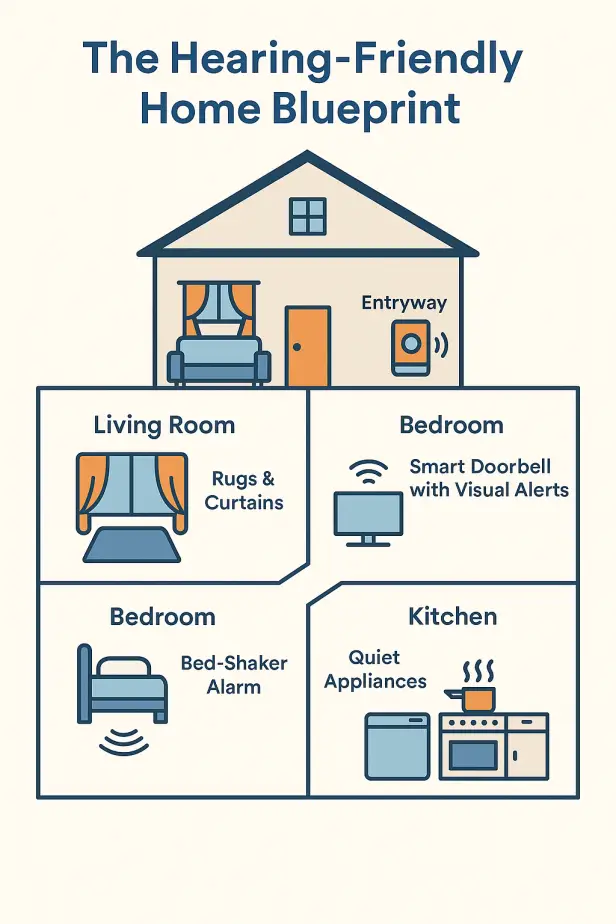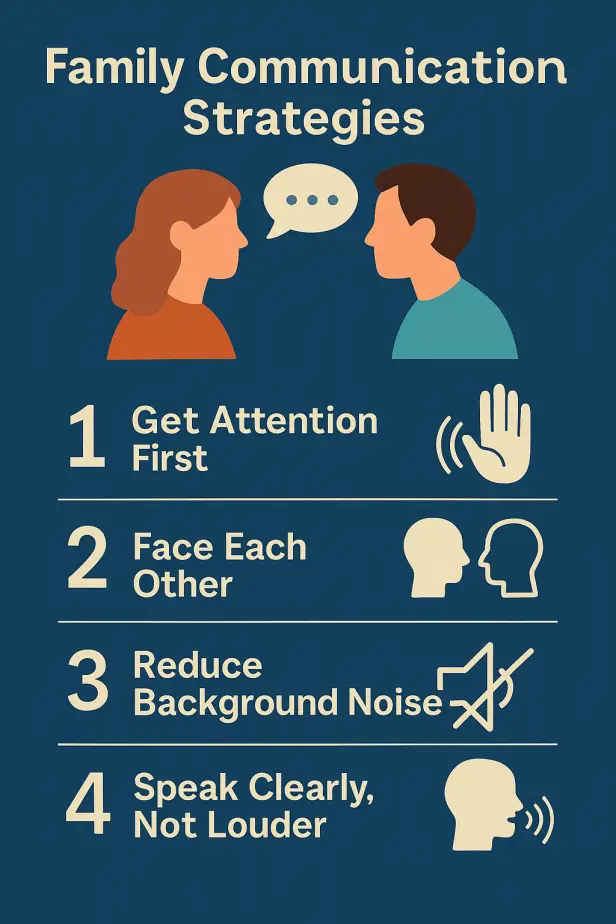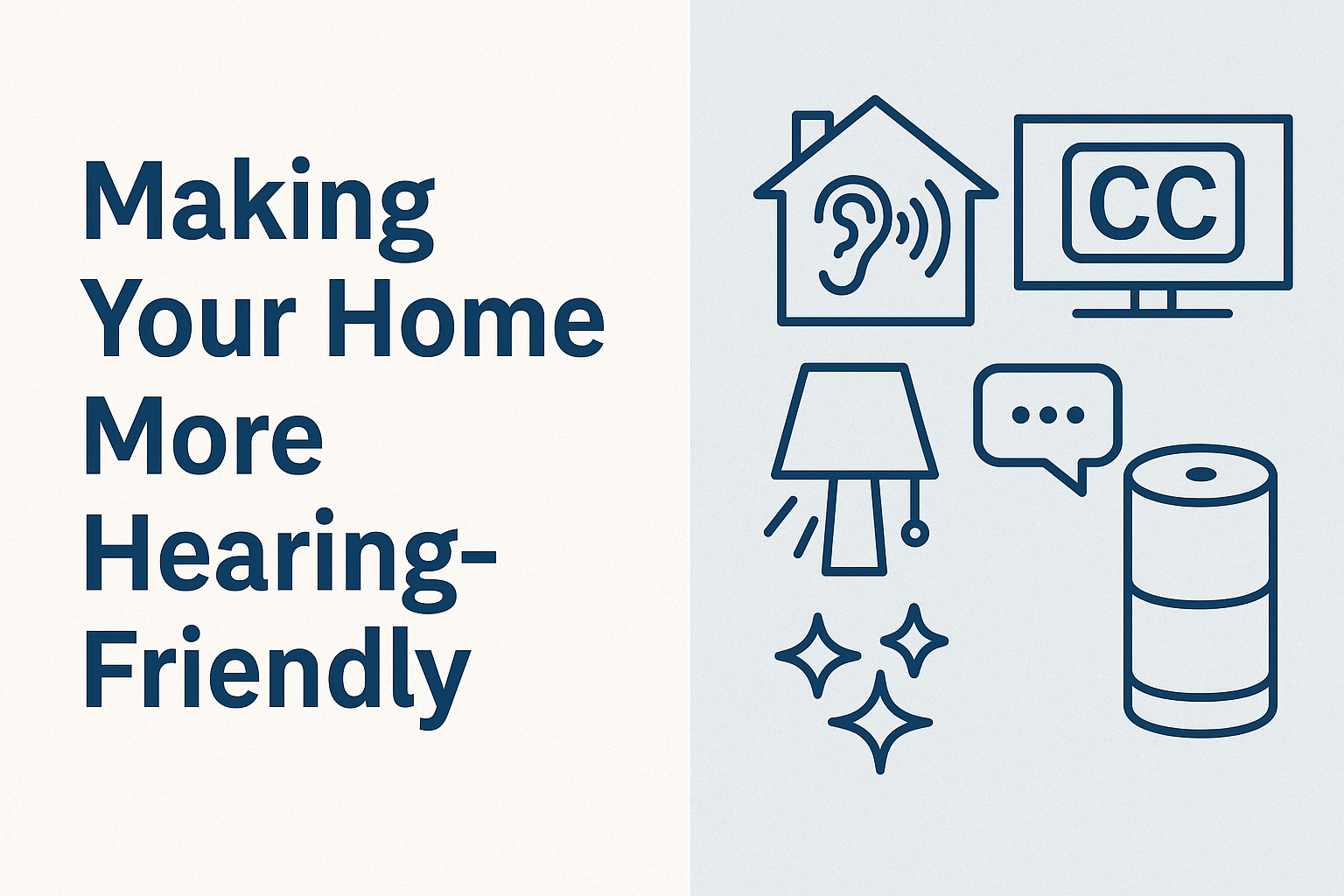By Dr. Jonathan Javid, Audiologist
Hearing loss doesn’t just change how you listen — it changes how you live in your own home. Missed alarms, muffled TV dialogue, and difficulty following conversations in the kitchen or living room are daily frustrations for millions of Americans.
As an audiologist with over 12 years of experience helping veterans and older adults, I’ve seen firsthand how hearing aids alone are not enough. Your home environment plays a critical role in how well you hear, communicate, and stay safe.
This expanded guide combines clinical expertise, research-backed strategies, and practical solutions to help you transform your living space into a hearing-friendly home.

Why a Hearing-Friendly Home Matters
Health & Safety
- According to the Centers for Disease Control and Prevention (CDC), adults with hearing loss are more likely to experience falls and safety risks if they miss auditory alerts like alarms.
- Traditional smoke and carbon monoxide detectors often emit high-frequency tones — the exact range most people with age-related hearing loss struggle to hear.
- Seniors aging at home without accessible alert systems are at increased risk during emergencies.
Social & Emotional Well-Being
- Research from the Hearing Loss Association of America (HLAA) shows that communication breakdowns at home often lead to withdrawal and frustration — not just for the person with hearing loss but also for family members.
- Untreated hearing loss is strongly associated with social isolation, depression, and cognitive decline (Johns Hopkins study).
Real-World Example
One of my patients, a retired teacher, once told me: “I stopped answering the door because I never heard the doorbell. I didn’t want to risk embarrassing myself with delivery drivers or neighbors.”
A simple smart video doorbell paired with a flashing light system restored her confidence and reduced her anxiety about living alone.
Step 1: Optimize Room Acoustics
Why Acoustics Matter
Even the best hearing aids can’t fully overcome echo and reverberation. Hard surfaces like tile, glass, and hardwood floors cause sound waves to bounce, making speech sound blurry.
Clinical Tip: I often demonstrate to patients how adding a single rug to a room makes voices easier to understand. They are amazed at how quickly acoustics affect clarity.
Practical Solutions
- Curtains & Rugs: Use heavy fabric curtains and area rugs to absorb sound.
- Bookshelves & Wall Hangings: Double as sound diffusers.
- Acoustic Panels: Foam or decorative fabric panels can dramatically reduce echo in kitchens and living rooms.
👉 More details: DIY Acoustic Fixes That Improve Clarity
Step 2: Improve TV & Entertainment Listening
Why TV Dialogue Is Hard to Hear
- Flat-screen TVs prioritize slim design over speaker quality.
- Dialogue competes with background effects and music.
- Age-related hearing loss affects high-pitch consonants that carry speech clarity.
Solutions I Recommend in Clinic
- TV Streamers:
- Phonak TV Connector, Oticon TV Adapter, ReSound TV Streamer 2.
- These send sound directly into your hearing aids, bypassing room acoustics.
- Soundbars with Speech Enhancement:
- Brands like ZVOX or Sonos have “dialogue boost” modes.
- Closed Captions: Essential but not always reliable with live broadcasts.
👉 Read the full setup guide: The Definitive Guide to Setting Up Your Living Room for Clear TV Dialogue
Step 3: Accessible Alerts & Notifications
Why This Is Critical
Missing an oven timer is inconvenient. Missing a smoke alarm could be life-threatening.
Audiologist Case Example:
A veteran of mine once slept through a smoke alarm. After installing a bed-shaker alarm linked to a flashing-light smoke detector, he told me it was the first time he felt safe sleeping alone in years.
Recommended Solutions
- Doorbells: Ring or Nest video doorbells send visual alerts to your phone.
- Smoke/CO Alarms: Brands like SafeAwake or Kidde offer flashing strobe and vibrating bed-shaker systems.
- Whole-Home Systems: Integrate alerts for phone calls, alarms, and visitors.
👉 Compare options:
- Smart Home Tech for People Who Don’t Hear Doorbells or Alarms
- Affordable Home Alert Systems for Seniors
Step 4: Simple Accessibility Upgrades
Easy Changes That Make a Difference
- Lighting: Good lighting improves lipreading and facial cues.
- Quiet Appliances: Choose dishwashers and fridges with low decibel ratings.
- Floor Plans: Open layouts reduce barriers, though acoustic treatment may still be needed.
- Visual Cues: Smart displays or whiteboards for reminders and communication.
👉 Learn more: Easy Home Upgrades for Better Accessibility
Step 5: Leverage Smart Home Assistants
Why I Recommend Them in Clinic:
Patients often struggle with medication schedules, answering the door, or remembering appointments. Smart assistants can provide hands-free solutions.
Examples
- Amazon Alexa or Google Home
- Flash smart lights when the doorbell rings.
- Provide voice-activated reminders (“Alexa, remind me to take my hearing aid batteries out at night”).
- Smart displays add captions to voice commands.
👉 Full tutorial: How to Use Alexa/Google Home for Better Accessibility
Step 6: Family Communication Strategies

Hearing-friendly homes don’t just depend on technology — they depend on people.
Audiologist Tips I Teach Families
- Get Attention First: Tap a shoulder or wave before speaking.
- Face Each Other: Eye contact + facial expressions = natural cues.
- Turn Down Background Noise: Pause the TV or dishwasher before talking.
- Speak Clearly, Not Louder: Shouting distorts speech and often makes it worse.
Family Example
One couple I worked with established a “TV pause rule” — whenever one wanted to talk, they would pause the TV. They told me it dramatically reduced arguments and misunderstandings.
Comparison Table: Professional Recommendations
| Category | What It Fixes | Examples | Cost Range |
|---|---|---|---|
| Acoustic Fixes | Echo & reverberation | Rugs, curtains, panels | $ |
| TV Solutions | Muffled dialogue | TV streamers, soundbars | $$–$$$ |
| Alert Systems | Missed alarms & doorbells | Bed-shakers, flashing alerts | $$–$$$ |
| Accessibility Upgrades | Visual support | Lighting, quiet appliances | $–$$ |
| Smart Assistants | Reminders & alerts | Alexa, Google Home | $$ |
FAQ: Making Homes Hearing-Friendly
1. What is the most important home upgrade for hearing loss?
If safety is the concern, alert systems (flashing smoke alarms, bed-shakers) come first. For communication, start with acoustic improvements and a TV streamer.
2. Are these upgrades only for seniors?
Not at all. Families with children who are deaf or hard of hearing, veterans with service-related hearing loss, or even those with tinnitus can benefit.
3. Do hearing aids alone fix TV listening problems?
No. While they amplify sound, they don’t always separate dialogue from background noise. A TV streamer or soundbar is often needed.
4. Are smart assistants secure?
Yes, if set up properly. Both Alexa and Google have privacy settings that allow you to manage voice recordings and device connections.
5. Do insurance or VA benefits cover home alert systems?
Sometimes. The VA often provides alerting devices for eligible veterans. Check with your audiologist or local VA clinic.
Final Thoughts from an Audiologist
After years of working with patients, I’ve learned that hearing aids work best in homes that support them. A hearing-friendly home is not about buying gadgets — it’s about creating an environment where communication and safety come naturally.
If you or a loved one are living with hearing loss, start small: add a flashing doorbell, improve lighting, or rearrange your living room. Over time, these adjustments build into a home that restores confidence, independence, and peace of mind.
Your home should work with your hearing, not against it.

